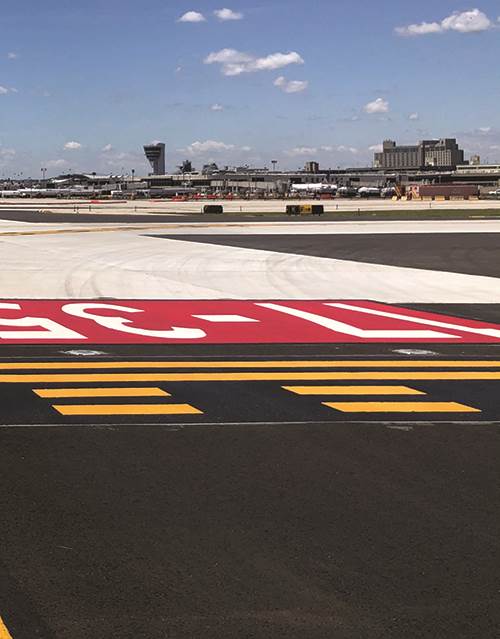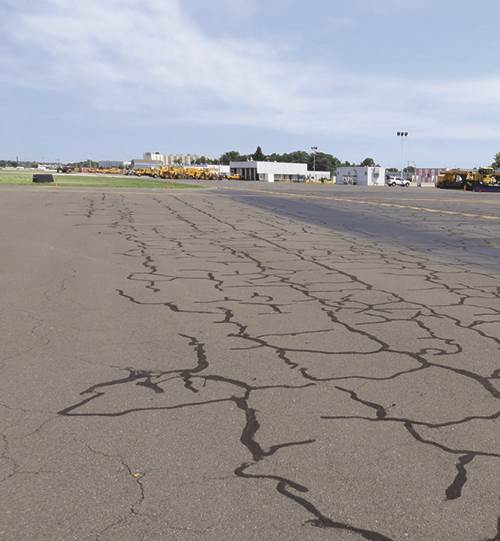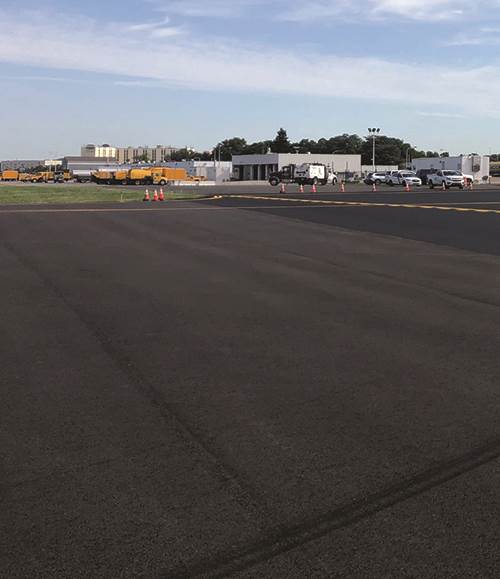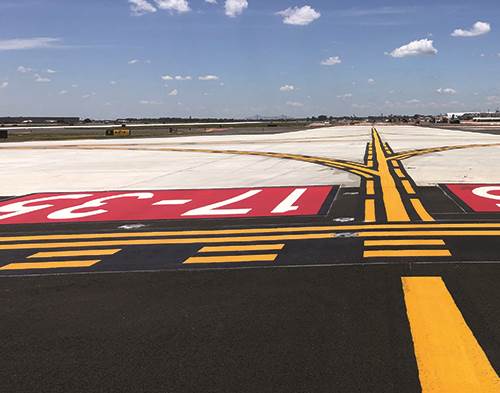The multi-year $25 million East Airfield Rehabilitation at Philadelphia International Airport (PHL) was completed 71 days early—and that was after having to shut down due to COVID-19. With construction progressing so fast and money still in the budget, PHL even managed to take advantage of reduced airfield traffic from the pandemic to add extra taxiway overlays to the project scope.
The multi-year $25 million East Airfield Rehabilitation at Philadelphia International Airport (PHL) was completed 71 days early—and that was after having to shut down due to COVID-19.
 With construction progressing so fast and money still in the budget, PHL even managed to take advantage of reduced airfield traffic from the pandemic to add extra taxiway overlays to the project scope.
With construction progressing so fast and money still in the budget, PHL even managed to take advantage of reduced airfield traffic from the pandemic to add extra taxiway overlays to the project scope.
The addition of an extra 38,500 square yards of mill-and-replacement work toward the end of the project was in keeping with its roots. Originally, the work scope only included the replacement of the North Apron, but it expanded to cover eight separate areas totaling 132,500 square yards and was eventually dubbed the East Airfield Rehabilitation project.
|
facts&figures Project: East Airfield Rehabilitation Location: Philadelphia Int’l Airport Cost: $25 million Funding: 75% federal; 25% state & local Scope: 132,500 sq. yards of new pavement in 8 areas, including 2 aprons, multiple taxiways & taxiway intersections Unexpected Element: Crews had to remove more than 26,500 sq. yards of asbestos-tainted asphalt Construction: March 2019-July 2020 Of Note: Project completed 71 days ahead of schedule
Design & Construction Manager:
Prime Contractor: Construction Safety & Phasing Design: Airport Design Consultants Inc.
Airfield Electrical Design:
Airfield Pavement Design:
Electrical Subcontractor: Asphalt Supplier: Delaware Valley Asphalt, an H&K plant
Concrete Supplier:
Concrete Services & Environmental Remediation: Pavement Marking Subcontractor: Zone Striping Inc. |
Jay A.C. Kellogg, project manager for general contractor Haines & Kibblehouse (H&K), notes that the firm did not receive deadline extensions associated with the COVID-19 shutdown or additional work.
Kellogg credits effective collaboration between PHL and all the stakeholders for the notably early finish. He also says that having the opportunity to tweak project plans after securing the work in late 2018 was a pivotal factor.
Much of the design work by Johnson, Mirmiran & Thompson (JMT) was completed on schedule in 2017 and early 2018. It included meetings with airport operations, the airlines and the FAA to assess safety zones and work timelines. Kyle Watson, JMT’s construction manager for the project, notes that all the stakeholders had a good feel for what was needed regarding phasing and night shifts by 2018 and 2019.

After the design project was bid and awarded to H&K, the airport assigned JMT to manage the construction of the project under a separate program management/construction management contract.
Because construction contracts were awarded late in the 2018 construction season, electrical suppliers were not able to get materials needed in the first phase. At H&K’s request, the airport delayed construction until spring.
“We planned through the winter and tweaked the phasing schemes that had originally been put together,” explains Kellogg. “We re-aligned them to get some phases done faster.”
Construction began in March 2019 and was completed in July 2020.
To meet the deadline, H&K had multiple crews working around the clock. One group was active in a given area during the day, and another crew worked at a different site at night. Night work on active taxiways could only occur from 10 p.m. to 6 a.m.
Although H&K had experience with airport projects, this was its first at PHL. The firm has subsequently won several other PHL bids.
Scope Sprawl
The East Airfield project was originally conceived in 2016 as the rehabilitation of the North Apron. The area was the site of PHL’s old overseas terminal, with pavement dating back to the 1970s. Portions of the concrete had deteriorated to the point that it posed a debris hazard to aircraft.
 Lia Sutanto, PHL’s airport engineering assistant manager, explains that the project team initially planned for a standard mill-and-replace project for the asphalt pavement sections. But further sampling and evaluation of the future parking operations indicated that full-depth reconstruction was necessary.
Lia Sutanto, PHL’s airport engineering assistant manager, explains that the project team initially planned for a standard mill-and-replace project for the asphalt pavement sections. But further sampling and evaluation of the future parking operations indicated that full-depth reconstruction was necessary.
JMT had completed about 90% of the design work for North Apron reconstruction when the airport decided to expand the project scope.

PHL’s pavement management program, prepared by JMT and RDM International, had identified several other areas on the eastside of the airfield that warranted repairs, pavement rehabilitation, or even complete reconstruction, explains Darren F. D’Achille Sr., design manager with Johnson, Mirmiran and Thompson. With the availability of federal funds, it became a “no brainer” to include the taxiways near the two aprons that were in poor condition and critical to accessing the runways, D’Achille explains. These new areas were rolled into the larger project with the North Apron.
 Project designers took into account that the area is frequently used for remote overnight parking of large aircraft—specifically, that the apron pavement is now holding aircraft heavier than it was originally designed to handle. The pavement on the South Apron, which is used as a “fuel-and-go” area for diverted aircraft and sport charters, only needed a new 4-inch overlay.
Project designers took into account that the area is frequently used for remote overnight parking of large aircraft—specifically, that the apron pavement is now holding aircraft heavier than it was originally designed to handle. The pavement on the South Apron, which is used as a “fuel-and-go” area for diverted aircraft and sport charters, only needed a new 4-inch overlay.
H&K crews consequently milled and replaced 66,600 square yards of asphalt apron and taxiways, reconstructed 36,300 square yards of asphalt taxiway pavement, and installed 29,600 square yards of concrete pavement on aprons and taxiways.

Initial planning meetings with stakeholders resulted in construction phases that only closed half an apron at a time, Sutanto notes. In addition, work had to be scheduled when deicing would not been needed, and sport charters were not using the area. “There were certain months we could get away with taking whole areas out of service,” she explains.
Moreover, PHL had several other airfield projects underway with other contractors at the same time.
Blast From the Past
Everyone was taken by surprise when crews discovered the widespread presence of asbestos in the North Apron asphalt.
While older plans indicated some asbestos mitigation and removal on the North Apron, Sutanto explains significantly more asbestos-laced pavement was discovered than what was expected.
“Asbestos has not been used in asphalt pavements for over 50 years and removal of the material is not a standard construction item for airfield projects,” notes D’Achille.
“PHL does have an alternative method/protocol in place to remove the asbestos,” Sutanto explains, “but it was deemed both inefficient and could potentially inflate cost and schedule to an unacceptable limit. We had to come up with a new method that allows us to remove it safely and quickly–allowing us to preserve the schedule and stay on budget.”
As few best practices for asbestos removal are available, the project team had to develop a new one. Two procedures were considered: a wet-milling operation that JMT designers suggested based on a standard from the Pennsylvania Department of Transportation, and a saw cut and removal method, which would slice and cut the top layer of asphalt and remove it intact. Coordination with local air quality agencies indicated a preference for the slice-and-cut method.
The slice-and-cut plan was selected and approved…but ultimately did not work.
Despite contractors using a variety of heavy excavation equipment and saws, the pavement broke apart into chunks of asphalt and concrete. Apparently, the binder holding the asbestos-laced asphalt to the concrete base had a stronger bond than either the asphalt or concrete. “It was not separating the way any of us had anticipated,” explains John Mast, manager of H&K’s Philadelphia operations at the time. “We had to find another method to take it out.”

Using the slice-and-cut method would have required a much larger amount of debris to be disposed of as hazardous materials.
 So H&K revived the milling strategy and attached extra misting sprayers to its equipment to keep the entire area wet. Mast explains that most of the dust was captured with special HEPA-equipped vacuum hoses at the grinding heads, and additional sprayers were attached to the tip of the conveyor belt to wet down debris as it fell into specially lined dump trucks.
So H&K revived the milling strategy and attached extra misting sprayers to its equipment to keep the entire area wet. Mast explains that most of the dust was captured with special HEPA-equipped vacuum hoses at the grinding heads, and additional sprayers were attached to the tip of the conveyor belt to wet down debris as it fell into specially lined dump trucks.
In total, crews removed more than 26,500 square yards of asbestos-tainted asphalt from the North Apron. Air was continually monitored throughout the process and Mast reports no asbestos fibers were becoming airborne.
Kellogg notes that it took crews 15 days to remove the asbestos-tainted pavement, but the team spent about three weeks trying to get the slice-and-cut method to work and then developing safeguards for the grinding system that was ultimately used.
With the tainted asphalt removed, crews pulverized the concrete base to clear the area for full pavement reconstruction.
Before:

After:

Construction Suspended
When the novel coronavirus pandemic struck the United States last March, H&K had completed the bulk of the originally contracted work and was beginning the additional taxiway portions. Then, Pennsylvania’s governor ordered all construction projects to shut down, and the East Airfield project stood idle for two weeks.
After the project was deemed essential, the team was allowed to re-start with COVID-specific health and safety plans. “We were the first to open again at the airport,” Mast notes.
Plans included provisions for social distancing, additional portable restrooms, hand-washing stations with hot water, virtual meetings and mask mandates.
Sutanto notes that none of the contractors working on the project reported any positive COVID-19 tests.
Looking back, Watson says that less traffic on the airfield benefited the project, but only slightly because most of the work was already completed. The slowdown did, however, help crews complete the newly assigned taxiway work faster, because additional areas were closed.



